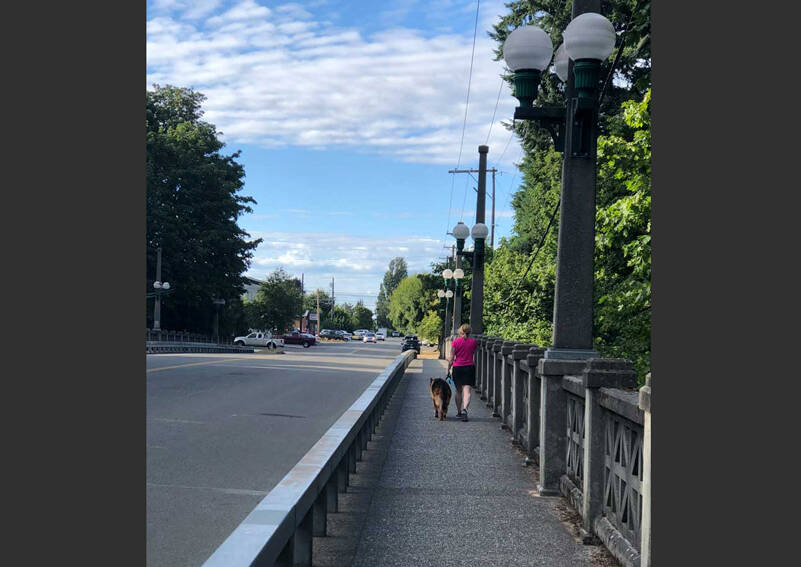By Morf Morford, Tacoma Daily Index
It’s not your imagination; the streets locally and nationally are far more dangerous than they used to be.
It’s not gangs, or immigrants or impaired drivers. And it’s not the vehicles – at least in the way we might have expected.
More of us drive more and further than ever before. Cars get good to great milage and more electric or hybrid cars are on the road. Vehicles are safer, far safer in fact, than they were just a few years ago. With restraints, multiple air-bags, protection zones and a full range of car seats, drivers and passengers – especially children – are vastly safer than a generation (or two) ago, as long as they stay inside a vehicle.
Stepping out of a vehicle is an entirely different story. American pedestrian deaths have surged 18%, or 519 additional lives lost, between the first half of 2019 and 2022. You can see the fine print on pedestrians on American streets here.
A walking tour of almost any neighborhood, in almost any urban area, will show far more areas closed or restricted to pedestrians than to vehicles.
War on cars?
If you’ve ever known an abusive person, in almost every manipulative/abusive situation there is one party who holds most if not all of the power, money and resources – and they almost always have an elaborate, highly convincing story about how they are the victim.
You could picture cars – and their advocates as doing exactly that.
Motor vehicles and their access (as in parking and transport) dominate state and local budgets – and virtually every urban (and suburban) landscape.
According to multiple surveys and aerial photos, vehicles along with their access and parking, take up about one fifth of the average urban center.
And most cities have an average of eight parking space for every car locally registered. If you think about it, most of us expect a parking place for every activity of our lives – or even a choice of where to park our much-loved vehicles.
We might be looking for proximity to our destination, shade, safety or accessibility or almost anything else, but above all we expect to decide where we park.
As you might guess, in most neighborhoods, this is prime real estate that could, at minimum, be used more productively.
I drive, therefore I am
Most, if not all of us, identify with, even define ourselves by what we drive. But who are we when our vehicle is “driven” by a set of algorithms, scanners and programmed setting?
Driverless cars were a hot topic not long ago. But perhaps what we need is not machines that don’t need humans, but humans that don’t need machines.
Consider, for example, how many times in the past month that you have gone a full day without being in a vehicle of some sort.
Road rage?
The term “road rage” has become commonly used. How could it not be?
In any design, or even relationship, we encourage behavior we want to see and discourage, even penalize behavior we don’t want to see.
What, for example, do we want our neighborhoods, city centers, even major thoroughfares to look like?
As we go to work, to entertainment or even to see friends or family, what is the experience we are looking forward to? And what is the experience we are most dreading?
I have a simple formula; I want to spend more time doing what I like than I spend on getting there. A one hour event or experience should certainly not take an hour – or more – to get there. A traffic jam or search for parking can (and usually will) distort this equation.
The reigning traffic philosophy seems to be the opposite; we add lanes to freeways to encourage more traffic, which means more cars, more accidents, and yes, more, not less “road rage”.
The premise that “more lanes reduce traffic” has been an expensive experiment in urban transport. A simple observation at almost any time of day or a brief look at traffic flows and safety records will show all too clearly how (in)effective these policies have been.
How “welcoming” are most neighborhoods?
Consider your ideal residential neighborhood – or even urban neighborhood. An ideal neighborhood or urban neighborhood is relatively subjective, but in simple terms, it is where any of us would want to go – and linger.
Too many of our thoroughfares seem to be specifically designed for exactly the opposite purpose – to get people out of the area as quickly as possible.
One neighborhood near where I live is always busy – with dog-walking residents, children on bikes, and active neighbors. There are ample sidewalks, many large trees and very little vehicle traffic.
A few miles away, across town there are vast barren areas with few if any trees, massively rushing traffic and virtually no pedestrians – for mile after mile. There are sidewalks, but they are alongside 4-6 lanes of constant traffic. They are loud, uncomfortable and dangerous – and they are continuously cut by access to vast and barely used parking lots. As you might guess, these extra wide sidewalks are rarely used by pedestrians.
School zones should be the safest place for kids on their to school or home. But we all know how precarious they can be.
When I travel, especially overseas, I find that my favorite places are those local streets filled with markets, fresh fruit or local delicacies, music, festivities and the quiet hum of human interactions. And when I get home, I am always struck by how empty our streets are of people or any living things.
We can do better. We just need to remember who our streets and neighborhoods are for.






